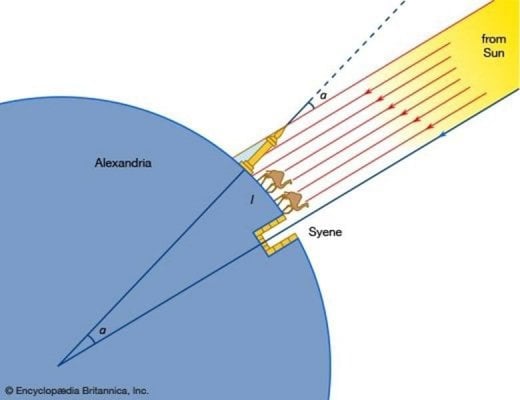Dirigido a cabezas planas que pretenden que a la NASA se le ocurrió la idea: Eratóstenes mide la Tierra. Ca. Junio de 240 a.C. En el siglo V a.C., era ampliamente aceptado que la Tierra era una esfera. Este es un punto crítico, ya que existe la idea errónea de que los pueblos antiguos pensaban que la Tierra era plana. El logro más famoso de Eratóstenes es su medición de la circunferencia de la Tierra. Registró los detalles de esta medición en un manuscrito que ahora se ha perdido, pero su técnica ha sido descrita por otros historiadores y escritores griegos.
Eratóstenes había oído hablar a los viajeros de un pozo en Siena (actual Asuán, Egipto) con una propiedad interesante: al mediodía del solsticio de verano, que ocurre alrededor del 21 de junio de cada año, el sol iluminaba todo el fondo de este pozo, sin proyectar ninguna sombra, lo que indicaba que el sol estaba directamente sobre su cabeza. Eratóstenes midió entonces el ángulo de una sombra proyectada por un palo al mediodía en el solsticio de verano en Alejandría, y descubrió que formaba un ángulo de unos 7,2 grados, o aproximadamente 1/50 de un círculo completo. Al conocer la distancia entre Siena y Alejandría con la ayuda de topógrafos profesionales, pudo informar que la circunferencia de la tierra era de 250.000 estadios o entre 24.000 y 29.000 millas.
Ver figura adjunta!!!
Addressed to flat heads pretending that NASA came up with the idea: Eratosthenes Measures the Earth. ca. June, 240 B.C.
By the 5th century B.C., it was widely accepted that the Earth is a sphere. This is a critical point, as there is a widespread misconception that ancient peoples thought the Earth was flat.
Eratosthenes’ most famous accomplishment is his measurement of the circumference of Earth. He recorded the details of this measurement in a manuscript that is now lost, but his technique has been described by other Greek historians and writers.
Eratosthenes had heard from travelers about a well in Syene (now Aswan, Egypt) with an interesting property: at noon on the summer solstice, which occurs about June 21 every year, the sun illuminated the entire bottom of this well, without casting any shadows, indicating that the sun was directly overhead. Eratosthenes then measured the angle of a shadow cast by a stick at noon on the summer solstice in Alexandria, and found it made an angle of about 7.2 degrees, or about 1/50 of a complete circle. By knowing the distance between Syene and Alexandria through the help of professional surveyors, he was able to report that the circumference of the earth was 250,000 stadia or between 24,000 and 29,000 miles.


